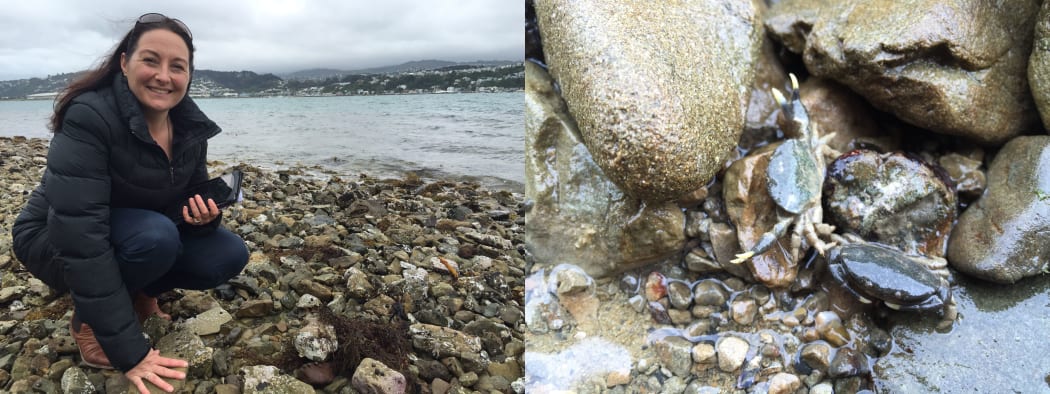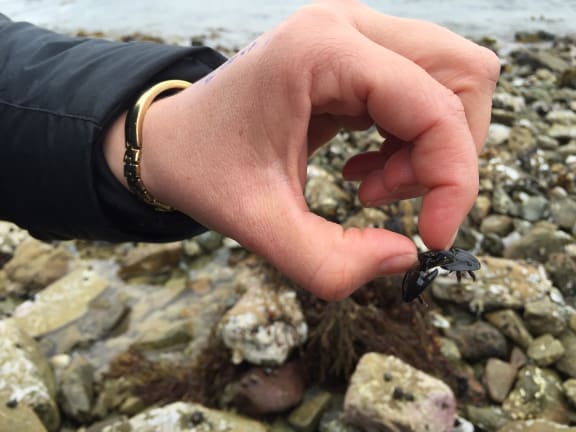
Shelly Bay in Wellington looks deserted but Serena Wilkens says there are families of crabs hidden under nearly every rock, including this porcelain crab, which can grow to 4cm in size. Photo: RNZ / Daniela Maoate-Cox
Clambering around a beach to find starfish, sponges, and crustaceans lurking in the rock pools is part of a classic kiwi summer.
But more often than not the exact details of what each species and its varieties are called remains a mystery, so NIWA, has released a series of interactive PDF e-guides to help amateur scientists identify the creatures around them.

NIWA marine biologist Serena Wilkens demonstrates how to pick up a crab. Photo: RNZ/ Daniela Maoate-Cox
Behind the latest guide on Coastal Crabs is marine biologist Serena Wilkens who was hooked on marine life from an early age.
“Even as a little girl I was always playing in the water and growing up in the water and I think it was just a natural progression for me. As I got older and I could learn to scuba dive I did, I went snorkelling as much as I could, I went fishing whenever I could. Then when I found out I could do this for a career it was all on”.
Serena went on to study marine biology at University where she gained a PhD which landed her a job doing what she loves at NIWA.
“I’m pure marine biology. Whether it’s on top of the water or under the water, I do a lot of diving, a lot of field work and obviously there’s office work as well,” she says.
“It’s a job with a lot of variation and is a very rewarding career, being out on boats; I think it’s all just really enjoyable.”
She’s not the only one who finds it attractive. Statistics New Zealand data shows the number of women working in life sciences jumped to 44 percent in 2013. Double what it was in 1991.
Serena’s hopeful the guides will lure more people to paying attention to what’s around them and encourage the next generation to enter the career as well.
“I think New Zealanders have grown up with the marine environment right on their back doorsteps and I think it’s fair to say most children have a fascination with what’s hiding under rocks and living in rock pools,” she says.

Potential marine biologist Taylah Nightingale shows how crabs pinch their claws. Fellow classmate, Madison Wilkens is sure that crabs like to eat grass. Photo: RNZ / Daniela Maoate-Cox
That fascination can be found in New Zealanders as young as two years old. At Kindercare Upper Hutt the children already know two songs and a story about kai moana, taniwha and sharks.
Their knowledge of crabs is diverse. Benji Murdoch knows crabs are orange and Madison Wilkens knows they can pinch and live in the water.
Everyone agrees that crabs eat grass but that might be something best checked in the guide which Serena says is purposely designed for anyone to pick up and use.
“They are really clear and they’re really easy to follow, which is one of the reasons we developed them and made them simple,” she says.
As well as crabs, NIWA’s free e-guides to coastal critters cover Awesome Ascidians, Splendid Sponges and Extraordinary Echinoderms.
Serena Wilkens has been on Our Changing World previously, talking about how marine larvae are attracted to the hulls of boats by underwater ship noise such as generators.

Some of the Kindercare students might have their sights set on a career as a food critic. George Beets and Hudson Glover munch on a crab. Photo: RNZ / Daniela Maoate-Cox

